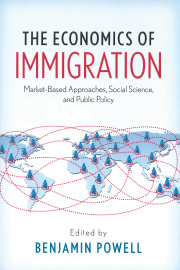Immigration policy is one of the most economically significant and politically divisive issues there is, often producing far more passion than reason.
Just the other day, on Oct. 8, for example, more than 150 protesters, including eight members of Congress, were arrested for blocking traffic on a busy Capitol Hill street during an immigration reform demonstration. While there was a lot of commotion, the complex issues involved were barely discussed.
U.S. immigration policy, since 1965, has restricted the number of foreign workers through a quota system that allocates the workers across various visa categories.
In 2013, the quota for permanent employment-based green cards was 140,000. In addition, the system provided for 65,000 temporary work visas for highly skilled workers in specialty occupations (H1-B visas) and 66,000 H2-B visas for temporary and seasonal workers. An additional 20,000 visas for advanced degree-holders were exempted from the caps, as were another category of visas (the H2-A program) for temporary agricultural workers.
The problem with the system is that it’s arbitrary and doesn’t meet the needs of employers, as our recent research confirmed.
In each of the last 10 years, we found, employer demand has exceeded the supply of H1-B visas for high-skill workers. The visas become available on April 1 for the following fiscal year, beginning Oct. 1. In fiscal 2013, the government ran out of H1-B visas in less than a week. Indeed, only twice in the last decade has the supply of H1-B visas lasted for more than half the fiscal year; in both instances, this occurred during economic downturns.
Similarly, in four of the last 10 years the demand for H2-B visas also has exceeded the cap.
The H2-A program, for temporary agricultural workers, has faltered for different reasons. Before visas can be issued to guest workers, this program requires potential employers to prove that no native-born workers are willing to take their jobs. But that’s almost impossible to prove. As a result, only about 30,000 foreign workers are in the United States under this plan.
The need, however, is much greater. The Western Growers Association, for example, has estimated that 80,000 acres of fruit and vegetable production moved out of California because of labor shortages. Perhaps the greatest evidence of the program’s inadequacy is the large number of illegals involved in agricultural work.
The Senate immigration reform bill would improve the existing system, nearly tripling the current H1-B visa cap and creating a new “W visa” for low-skilled workers—setting the initial cap at 20,000, increasing over time to as many as 200,000.
Despite these improvements, the bill still involves government micromanagement of the immigrant labor market, mandating visa caps for particular industries and dictating wage rates for particular job categories. Construction-related visas, as an example, would be limited to 15,000—in an industry employing some 5.8 million—and foreign crop-harvesters would have to be paid exactly $9.17 per hour.
Government planners have no way of knowing how many foreign workers an industry requires or the correct wage rate. Market forces need to set prices and quantities for labor markets to function efficiently.
There is a better way. It’s known as the “Red Card” guest-worker plan, an idea being promoted by Denver’s Vernon K. Krieble Foundation.
Rather than building border fences to keep job-seekers out, or regulating the number of workers through quotas, the Red Card plan would base the number and allocation of visas on labor market demand.
The plan is seen as a simple way for guest workers and their families “to legally come to the U.S. for specific jobs and for a specific period of time.” Each worker would be required to undergo a background check, would be issued an electronic smart card, or Red Card, so employers and law enforcement officials could keep track of them, and would be required to return home at the end of their employment.
Private employment agencies would serve as intermediaries, opening offices overseas and matching available workers with available jobs.
The Red Card plan would not resolve the immigrant labor issue. But it’s a step in the right direction and would make the market for foreign-born labor more efficient.











